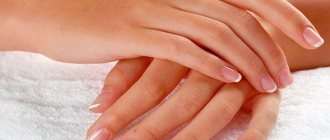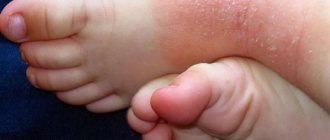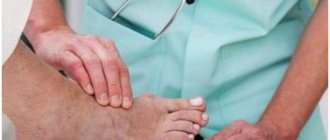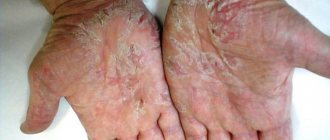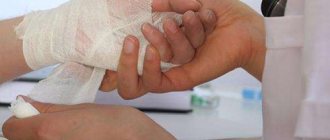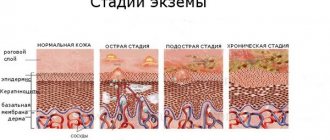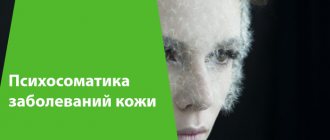Dyshidrosis of the hands: treatment
Treatment of a disease that has several causes is carried out comprehensively. Do not neglect any of the components of therapy:
- General treatment with medications.
- Local impact
- Physiotherapy.
- Diet.
- Avoiding contact with the irritant.
It is important to remember that treatment should be carried out only as prescribed and under the supervision of a doctor. Self-prescriptions can lead to the disease becoming chronic and worsening the condition.
General treatment
- Antihistamines. Used to eliminate itching and reduce the body's reaction to allergens.
- Sedative medications. They normalize nervous excitability, which provokes exacerbation.
- Immunocorrection.
- Vitamins. Normalize skin condition and support immunity.
- Anti-inflammatory therapy. Non-steroidal drugs such as Indomethacin are used.
- Diuretics.
- General strengthening preparations containing calcium, magnesium and potassium.
Local impact
Treatment is carried out in accordance with the identified dominant cause of the disease.
- In case of excessive sweating and the presence of vegetative-vascular dystonia, the palms are lubricated with a solution of atropine 0.1-0.25% concentration. In this case, 0.5% novocaine is taken orally.
- If there is a clear connection between the exacerbation of dyshidrosis and a fungal infection, the mycosis is first treated with ointments and, if necessary, general medications.
- Then drying and anti-inflammatory ointments, baths and lotions are used. Use zinc ointment, salicylic acid, potassium permanganate, boric acid, Furacilin, Burov's solution.
- Folk remedies include lubrication with celandine juice, aloe, baths with sage, chamomile, string, and oak bark.
Physiotherapy
It is prescribed when acute manifestations of the disease subside. The goal is to normalize metabolic processes in the skin, improve blood circulation, eliminate itching and harmonize the nervous system. Considered the most effective
- magnetic therapy,
- electrophoresis,
- mud and seaweed wraps,
- acupuncture,
- paraffin applications,
- cold exposure,
- laser therapy,
- ultraphonophoresis,
- ozone therapy
- acupuncture.
Diet for dyshidrosis
Changing your diet will help relieve allergy in the body, improve digestion, eliminate adverse effects on the nervous system, and maintain a healthy heart.
Should not be consumed
- citrus,
- red fruits,
- nuts,
- chicken,
- chocolate,
- honey,
- coffee,
- tea,
- natural milk,
- canned food,
- alcohol,
- products containing gluten.
- spicy, salty, fatty.
Recommended
- fresh vegetables and fruits,
- dairy products,
- buckwheat, rice porridge,
- legumes,
- corn,
- butter and vegetable oil
- dietary meat (beef, turkey, rabbit).
Cooking method: preferably boil or steam or bake.
Drinking regime: you should drink at least 2 liters of water during the day, including juices or green tea.
Avoid contact with the irritant
When identifying an allergenic cause of the disease, it is imperative to interrupt contact with the provoking agent - chemical, cosmetic, natural. If complete elimination is not possible, protective equipment should be used.
Dyshidrosis requires careful attention to yourself. If you follow the treatment rules prescribed by your doctor, the cure will not take long, and exacerbations in the chronic form will be rare.
Features of the treatment of dyshidrosis in children
Dyshidrosis in children: treatment features:
1. There are no standard treatment regimens for this pathology for children. Medicines are prescribed for each child strictly individually. Drug regimens are combined in different ways. 2. Corticosteroid medications are prescribed only for aggressive disease. 3. Early addition of antibacterial drugs in order to prevent fungal and bacterial infections from joining, as children scratch the affected areas of the skin. 4. Mandatory search for the allergen that causes the reaction. And stop contact with him. 5. Mandatory prescription of mild sedatives if the pathological process is triggered by a stressful situation.
Diet for dyshidrosis
Before treating dyshidrosis of the hands, it is necessary to normalize the patient’s diet.
Basic principles of the diet:
1. Eliminate foods that cause allergies. 2. Limit foods high in simple carbohydrates. 3. Fermented milk and vegetable products should prevail in the diet. 4. Eat only lean meats. 5. Increase the percentage of coarse fiber in the diet. 6. There are more products made from durum flour.
It is necessary to exclude or sharply limit the following products:
• citrus fruits; • fish; • sausages; • strawberries; • bakery; • marinades; • Exotic fruits; • foods containing a lot of salt; • chocolate; • canned food; • nuts; • confectionery products.
Prevention
To prevent exacerbations it is necessary:
• compliance with the rest and work schedule; • balanced diet; • regular intake of vitamins; • avoid contact with allergenic substances; • do not use household chemicals; • avoid traumatic situations; • avoid exposure to aggressive temperatures on the skin; • enhanced hygiene; • thorough treatment of cuts and skin injuries; • hold printed publications in your hands; • use only high-quality cosmetics; • avoid physical fatigue.
All these measures, along with regular visits to a certified dermatologist and strict adherence to his instructions, will help to significantly reduce the frequency and severity of exacerbations.
Symptoms
The disease occurs with periods of exacerbation and remission, and is characterized by a long chronic course. Initially, vesicular rashes with clear liquid contents are noted.
The blistering rash has a diameter of 1 to 55 mm. The elements are located quite deep, their appearance is accompanied by severe itching. Dyshidrotic eczema affects the legs, feet, lateral surfaces of the fingers and palms. In some cases, the rash is observed on the top of the hands.
As the pathology progresses, the blisters open and erosions appear. When rash elements merge, wounds and cracks can occupy large areas of the body. The next stage is the formation of crusts. The whole process takes from 1 to 3 weeks, the skin on the affected area darkens. As the disease progresses, the epidermis thickens, turns red, becomes cracked and peels off. Often this form of eczema leads to atrophy of the nail plates.
What is dyshidrosis
Dyshidrosis is a disease from the dermatological group. Its favorite location is the palmar surface of the hand and, less commonly, the plantar surface of the foot. The disease is characterized by the appearance of vesicles (bubbles with transparent liquid contents) inside the epidermal layer of the skin; as a rule, they are filled with transparent liquid contents. This is not a block of sweat gland ducts, as previously thought. For dyshidrosis, a clear connection between exacerbation and seasonality is typical.
Most often, dyshidrosis affects patients at a young age (14-40 years). Both women and men suffer from it with equal frequency.
There are two forms:
• chronic, accompanied by periodic exacerbations; • acute form.
It is important to remember that this disease: • is not contagious to other people; • responds well to therapy; • not dangerous to life and health.
Causes of dyshidrosis
The leading factor of the disease has not yet been identified. Currently, several more likely causes of dyshidrosis are being identified.
Dyshidrosis of fingers, causes:
• hereditary cause of the disease; • prolonged stress; • defects in the functioning of the endocrine system; • chronic fungal infections of the skin; • vegetative-vascular dystonia; • chronic bacterial infections; • autoimmune lesions; • digestive system disorder; • disruptions in cellular metabolism; • nervous overstrain; • consequences of chemical agents on the body; • allergic reactions.
Thus, true dyshidrosis, today, is considered a polyetiological disease.
Classification
Currently, there are four forms of dyshidrosis.
There are:
• true dyshidrosis; • symptomatic; • dyshidrotic eczema; • dry lamellar dyshidrosis.
Symptoms of dyshidrosis
With dyshidrosis, all symptoms are clearly expressed from the very onset of the disease. A certain stage is typical for the manifestation of symptoms of the disease.
Hand skin dyshidrosis, symptoms:
1. First, the patient begins to experience a burning sensation in the palms and fingers or a feeling of warmth. 2. Then comes a vesicular rash with small blisters, their size no more than five millimeters. The bubbles are filled with transparent liquid contents. 3. Swelling of the skin of the palm and fingers appears. 4. Vesicles have a tropism (tendency) to merge. Large vesicles burst. 5. The skin on the palms cracks and peels off. This phenomenon is accompanied by pain, itching and burning. 6. When the process is delayed, the patient becomes irritable. 7. In advanced cases, complications may arise from the addition of fungal and bacterial infections. 8. Deep cracks in the epidermis may appear. 9. Possible enlargement of nearby lymph nodes. 10. The healing stage is characterized by the skin becoming rougher and flaking.
Diagnostics
The diagnosis of hyperhidrosis is made based on the characteristic clinical manifestations of the disease, complaints, medical history and examination of the skin. This diagnosis is made on the basis of exclusion. To make a diagnosis of hyperhidrosis of the hands and feet, differential diagnosis is very important. Because this pathology, in its external manifestations, resembles many skin pathologies. In other pathologies, dyshidrosis can be regarded as a syndrome. It must be differentiated from true hyperhidrosis.
It is necessary to make a differential diagnosis with other skin diseases:
• dyshidrotic eczema; • bullous impetigo; • fungal infections; • pustular psoriasis; • dyshidrotic epidermophytosis; • contact dermatitis.
A distinctive sign of dyshidrosis is:
1. The location of the vesicles is not on the surface of the epidermis, but inside it. 2. Another distinctive feature of it is its characteristic localization. Only the palms and soles are affected. 3. Also, this pathology is characterized by a clear seasonality (spring, autumn). 4. Dyshidrosis, unlike other skin pathologies, is characterized by a constant number of vesicular rashes.
Diagnostics
The diagnosis is made on the basis of the characteristic clinical picture of the disease (vesicular rashes on the skin of the palms and soles, itching, their recurrent nature).
Dyshidrotic eczema requires differential diagnosis with the following diseases:
- palmoplantar form of psoriasis;
- contact dermatitis;
- fungal skin infections.
To exclude fungal infections of the skin, microscopy of scrapings from the affected area is performed. When a secondary infection occurs, a bacteriological examination of the erosion discharge is performed. This laboratory diagnostic method allows not only to determine the causative agent of inflammation, but also its sensitivity to antibacterial drugs.
Diagnosis of dyshidrotic eczema on the hands
There are no specific diagnostic techniques aimed at identifying dyshidrotic eczema. However, this does not mean that you should not seek advice from a specialist. The doctor will evaluate the clinical picture, the location of the rash and be able to make a preliminary diagnosis. The chronic course of the disease with frequent relapses will only confirm the assumption made.
In addition, differential diagnosis is important, which makes it possible to distinguish this type of eczema from other forms of the disease, with mycotic lesions, contact dermatitis, and palmoplantar psoriasis. Therefore, the specialist sends the patient to have a scraping tested for pathogenic fungi, then the discharged contents of the erosions or the serous contents of the vesicles are inoculated. This allows us to confirm that the disease is not of a primary infectious nature, and if a secondary infection has occurred, then it becomes possible to choose the right treatment.
It is strictly not recommended to make a diagnosis yourself, much less begin treatment without visiting a specialist. In addition to the fact that it can aggravate the course of the disease, such amateur activity can lead to a distortion of the clinical picture characteristic of dyshidrotic eczema. This, in turn, can lead to medical errors and incorrect therapy.
Dyshidrotic eczema is differentiated from mycosis of the skin of the hands exclusively in the laboratory. A combination of two types of disease in one patient is not excluded.
Symptoms of dyshidrotic eczema
The most characteristic manifestation of dyshidrotic eczema on the hands and other parts of the body is a vesicular rash - a rash consisting of many blisters with a diameter of up to 4-5 millimeters, filled with liquid contents. In this form of the disease, the blisters are located deep inside the epidermis and, as a result, cause severe itching. In some cases, it precedes the formation of bulk elements. The palms, backs of the hands, soles of the feet, and sides of the fingers are the most common sites for the rash.
Some time after the appearance, the vesicles burst, the contents flow out, and areas of ulceration appear at the site of the rash. When several bubbles are opened, erosions can combine. Gradually, the ulcers heal and become covered with yellowish or brown crusts. The process of formation of new rash elements, their opening and healing can last up to 3 weeks; after healing, an area of hyperpigmentation (darkening) remains at the site of erosion.
With a long course of the disease, a constant, chronic change in the structure and appearance of the skin occurs. The skin turns red and thickens, deep cracks form on it, and areas of peeling appear. Dyshidrotic eczema is also characterized by the formation of areas of dry, dehydrated skin, resembling wax paper in appearance.
The entry of pathogenic microorganisms (for example, streptococci) into cracks and ulcers causes secondary infection. At the same time, the symptoms also change: most often, pustules with purulent contents form on the surface of the skin, and purulent inflammation of the skin occurs. Soreness, swelling and redness occur, symptoms of general intoxication appear - headache, fever, in some cases - nausea, appetite and sleep disorders, enlarged lymph nodes (axillary, elbow, inguinal, popliteal).
Despite the fact that there are acute forms of the disease, most often didyshidrotic eczema occurs in a chronic form with relapses occurring from time to time. Remissions can last up to several months. Exacerbations do not always occur upon contact with allergens or irritating substances and can occur against the background of complete health.
Reasons for development
The origin of the disease is still unknown. Allergists believe that the reasons for the development of dyshidrosis in a child are a combination of several factors.
Factors that provoke dyshidrosis in children:
- skin fungus;
- chronic inflammatory diseases;
- mental abnormalities;
- pathologies of the endocrine system;
- immune disorders;
- history of allergic diseases;
- prolonged stress;
- features of genetics.
Causes
Any eczema occurs for many reasons. Scientists have found that the coin-shaped form occurs more often after tonsillitis, hyperhidrosis, tuberculosis, and dental caries. It can be a consequence of stress or taking medications that significantly suppress the immune system. But the factors that cause the disease are not fully understood.
The specific cause of the disease is the presence of bacteria in the body. Due to sensitization of organs and systems, an inadequate skin reaction to antigens occurs. And if at first a similar response is observed when a specific type of pathogen appears, then the skin can respond similarly to other irritants.
The most likely version of the appearance of chronic coin-shaped eczema is the presence of epidermal dysfunction, in which the skin becomes more susceptible to the negative influence of the external environment. Because of this, pathogenic antibodies enter its deeper layers and provoke an inadequate reaction.
Then, when eczema plaques have already formed, a secondary infection may develop against the background of this disease, which further aggravates the disease.
What is dyshidrotic form of eczema?
Eczema is a disease that does not have an exact and unambiguous etiology. Depending on the localization of symptoms, pathogenesis and possible causes of occurrence, many of its subtypes are distinguished. Dyshidrotic eczema is one of the varieties that occurs in 8% of those who suffer from skin diseases. It manifests itself through blisters no larger than 5 mm in size, located on the palms and soles.
Previously, it was believed that the main cause of this type of eczema was blockage of the sweat glands. In reality, this is not the case, and sweat gland dysfunction has not been detected during dyshidrosis. The real cause of symptoms is an imbalance in the body.
Application rules
Local therapy should be carried out according to the following rules:
- Apply the ointment in a thin layer onto clean skin of the hands. To do this, before starting the procedure, you need to wash your hands with hypoallergenic soap, preferably baby soap.
- Before applying the product, it is recommended to take a bath with soda or decoctions of medicinal herbs: celandine, chamomile, calendula, sage. The water temperature should be approximately 38 degrees.
- After a warm bath, gently pat your hands dry with a clean napkin.
- The ointment is applied 2-3 times a day.
- Some medications can be applied under a bandage.
- The use of ointments should not be combined with lotions prepared from a resorcinol solution. In this case, an acute allergic reaction is possible.
The duration of such therapy is chosen by the doctor depending on the severity of the skin disease and the dynamics of the treatment.
Read whether toxicerma occurs in a child. Is it possible to cure hand dyshidrosis? The answer is here.
Is there chronic eczema of the hands? Details in the article.
Treatment of dyshidrotic eczema in children
A detailed treatment regimen is prescribed by the doctor. He focuses on the stage of the disease and the general condition of the child.
| Group of medicines | Action |
| Glucocorticosteroids for external use | Hormonal ointments relieve itching, burning, and peeling.
|
| Non-hormonal agents | They have an anti-inflammatory effect. Have a minimal number of side effects.
|
| Antihistamines | Relieves itching and produces a desensitizing effect.
|
| Antibiotics, antifungals | Preparations for external use. Prescribed for secondary infection of wounds with bacterial or fungal infection. Fight microbial pathogens.
|
When the first signs of eczema or rashes of unknown origin appear, the child should be shown to a doctor. Treating the disease on your own will only worsen the situation; the disease will quickly progress, worsening the condition. Qualified medical care will help stabilize the child’s condition and accelerate the onset of remission.
Review of popular drugs
Treatment of dyshidrosis of the hands with ointment gives positive results in combination with other methods of treating this disease, so this problem must be approached comprehensively.
The most effective drugs used for these purposes are fluoridated ointments based on corticosteroids.
Hormonal ointments are easy to use and are harmless even with long-term use.
All drugs from the group of glucocorticosteroids are prescription drugs, so you must visit your doctor to write a prescription for the appropriate medication.
In complex therapy, antibacterial, drying and moisturizing ointments can be used.
Find out what foot dyshidrosis looks like.
Interested in skin dyshidrosis? Click read. Let's consider the most popular means for external treatment of dyshidrosis:
- Fluorocort is an ointment from the group of glucocorticosteroids that relieves allergic reactions and inflammation and effectively combats itching. Has an antiexudative effect.
- Triderm is a combined action ointment that has antiallergic, anti-inflammatory, antipruritic and antiexudative effects. In addition, the drug has a broad antibacterial effect and is active against fungal infections.
- Polcortolone is an analogue of Fluorocort, and additionally has an anti-edematous effect. Recommended as a highly effective remedy for inflammatory reactions of allergic origin.
- Elokom is a hormonal ointment that effectively eliminates the main symptoms of hand dyshidrosis: inflammation, itching, watery blisters.
- Laticort is a synthetic glucocorticosteroid that can eliminate itching, swelling, inflammation, and allergic manifestations in the shortest possible time. The drug is prescribed for severe dyshidrosis.
- Salicylic ointment is a drug that is prescribed for the dry form of dyshidrosis, as well as at the exfoliation stage.
- Ichthyol ointment is an inexpensive antiseptic drug that effectively relieves itching and inflammation. It has a disinfecting effect, allows the skin to recover faster, and softens its top layer.
- Zinc ointment dries out watery formations and promotes their rapid removal.
- Tetracycline - needed when a secondary infection occurs, in the presence of severe scratching, wounds, cracks. The drug is a broad-spectrum antibiotic.
- Levomekol is an anti-inflammatory ointment containing an antibiotic. It is effective even when purulent discharge appears from wounds.
- Amyclone is an antifungal drug necessary in case of mycotic origin of the disease.
Only a dermatologist can correctly select a drug for the treatment of dyshidrosis, who will take into account the peculiarities of the course of the disease and possible contraindications. Sometimes a combination of ointments is required.
Symptoms and manifestation
Signs of true dyshidrosis of the hands are characterized by constancy and an almost constant number of bubbles.
The exacerbation process proceeds as follows:
- the hands are hotter in those places where bubbles will appear, but no redness of the skin is observed; during the process, swelling may occur on the hands;
- in the depths of the skin, the formation of intraepidermal vesicles occurs - small dense vesicles ranging in size from 2-3 to 5 mm, filled with clear serous fluid; at the initial stage they simply look like small bumps on the skin about 0.5 mm high, single or grouped, which feel like tiny grains;
- It will take about three weeks for the vesicles to “mature”, and this process is accompanied by dryness and flaking of the skin, as well as extremely uncomfortable burning sensations and severe itching, so that it is impossible to resist scratching the affected areas;
- often the formed vesicles merge, and the resulting bubble can burst spontaneously or under the influence of scratching, which threatens the open wound with infection and the development of suppuration if measures are not taken quickly;
- the process of opening the vesicles is accompanied by negative changes in the skin around the affected areas: the skin no longer just peels off, but cracks, its surface keratinized layer peels off, causing pain;
- Healing of the skin without appropriate treatment will be very long and painful, especially in places where large blisters form.
Dyshidrotic eczema on the hands It is impossible not to treat dyshidrosis on the hands - due to the penetration of infection into open wounds formed at the site of burst blisters, not only local suppuration in the form of phlegmon (subcutaneous ulcers) can occur, but also lymphangitis - inflammation of the lymphatic vessels, in which The lymph nodes in the armpits are mainly affected.
Complications
In addition, if treatment is not started in a timely manner and constant scratching of the affected areas increases the likelihood of the appearance of phlegmons and ulcers, as well as panaritium on the fingers. At the site of long-healing lesions, unsightly scars form, which can cause discomfort.
If you notice the first signs of dyshidrotic eczema, you should make an appointment with a dermatologist, who will make the correct diagnosis and prescribe treatment appropriate to the degree of damage.
What external agents are prescribed?
A mandatory part of the treatment of this disease is local therapy aimed at softening the affected areas of the skin, drying out watery blisters, relieving inflammation and allergies.
For this, various ointments, oils, lotions and pastes are prescribed. If a secondary infection occurs, ointments with antibiotics must be prescribed.
For external use you can successfully use:
- potassium permanganate;
- resorcinol;
- chamomile herbs;
- sequences;
- St. John's wort, from which you need to make warm baths or lotions.
It is recommended to carry out such procedures 2 times daily.
Symptoms
Eczema is quite rightly considered one of the hand diseases. Even with dyshidrotic eczema, which affects only the legs and arms, inflammation affects the legs in only 20% of all cases. Symptoms on the hands with the described pathology have many common points, but there are also unique manifestations.
True (idiopathic) eczema
Pronounced erythema of irregular shape, the size of red spots varies from a few millimeters to several centimeters. Numerous microvesicles are immature serous vesicles up to 1 mm in diameter. Almost immediately they turn into microulcers (the so-called “serous wells”), from which exudate protrudes onto the epidermis, forming a brownish crust.
After the scabs fall off, a healthy layer remains. But with frequent relapses, hyper- and hypopigmentation of the skin under the scabs occurs, its lichenification - the skin pattern changes, the skin furrows become deeper, and abnormal plateau-type thickenings are noted, reminiscent of flat calluses with deep cracks. Another sign of chronicity is constant peeling, both erythema and scabs. And all this against the background of itching and burning that never completely subsides.
Dyshidrotic eczema
It stands out because it always affects only the hands and feet, with the hands in 8 cases out of 10. At least, the disease begins with the palms. Erythema is mild; usually, the process begins with simple redness of the skin area. Then numerous, rather large (up to 5 mm), serous vesicles appear, sometimes merging into entire blisters. After resolution, weeping ulcers are left, covered with grayish-yellowish crusts. With frequent relapses against the background of dyshidrosis, true eczema often occurs.
Tilotic (horny, callus-like) eczema
The localization is completely identical to dyshidrosis. Erythema and rashes are not expressed due to the rapid formation of callosal thickenings.
Microbial (bacterial, viral) eczema
On healthy, intact skin it occurs only as:
- a spontaneously passing symptom of some kind of infection, for example, a rash with scarlet fever, yersiniosis;
- individual allergic reaction to pathogenic and conditionally pathogenic microflora.
In other cases, this form develops against the background of another skin lesion, when some kind of secondary infection is introduced into the damaged, inflamed areas.
Mycotic eczema
In fact, it is an unusual, additional symptom of a fungal disease, due to the fact that the immune response contains not only a standard reaction to the penetration of a foreign antigen, but also an allergic one. For fungal eczema, the main distinguishing feature is a sharp, very clear delineation of the affected area. Mycoses contribute to the transition of skin pathology into a chronic form, and hormonal treatment, common for eczema, is inhibited by the fact that fungi rapidly grow and mutate under the influence of hormones.
Allergic eczema
Occupational eczema is a special case of allergic eczematous lesion. Inflammation is caused by irritating factors and is of a chemical nature. The irritant can be anything: paint, metal, cleaning product, cosmetic, food, medicine, etc.
Childhood eczema
Differs in weak differentiation. Often there is a complex of not only skin, but also other allergic, infectious and inflammatory processes occurring at the level of the whole organism (bronchial asthma, conjunctivitis, gastrointestinal irritation, etc.). Not so long ago, for children under 5 years old, it was customary to call eczema an exudative diathesis, but later it turned out that such a diathesis is something of a universal “near-pathological” state of the child’s immune system. And against this background, more specific pathologies develop. Although a child’s hands are also attacked at the beginning of the disease, in childhood the process almost always tends to complete generalization at the level of the whole organism. This is why infants are at risk of toxic-allergic shock.
Causes and mechanism of development of dyshidrotic eczema
symptoms of dyshidrotic eczema Dyshidrotic eczema develops in both men and women. However, females are susceptible to earlier manifestations of the disease, around 20-25 years. The disease especially strikes during pregnancy, when the female body undergoes enormous changes. After childbirth, the symptoms of dyshidrosis disappear. In men, dyshidrotic eczema can develop after age 40. As for children, they get sick mainly under the age of 3 years, and then only those who have a genetic predisposition to allergic reactions and diathesis.
Dyshidrotic eczema manifests itself as a follicular rash filled with a purulent substance on the feet, hands, and nails. The most common is dyshidrotic eczema of the hands, which affects the palms and fingers (80%). Less commonly, dyshidrotic eczema affects the feet (20%). Never appears on such areas of the body as: face, neck, back, buttocks. Dyshidrotic vesicles are localized in groups under the upper epidermis, but can be located individually.
There is a special classification of dyshidrotic eczema: according to the forms and course of the disease. According to the forms, dyshidrotic eczema of the hands and feet can be:
- true, which develops as a primary disease;
- contact, caused by contact dermatitis;
- microbial, provoked by various types of infection: bacterial, viral.
According to the nature of the course of the disease, they are distinguished:
- spicy;
- chronic.
It is important to remember that dyshidrotic eczema is never transmitted by contact, from person to person. The disease is not contagious, so you should not avoid communicating with people suffering from this disease
There is a group of factors that can trigger the development of the disease. Among the most common reasons are:
- problems with metabolic or metabolic processes in the body;
- failure of the humoral (endocrine) and immune systems. Diseases such as diabetes mellitus, hyperthyroidism of the thyroid gland;
- diseases of the gastrointestinal tract: gastritis, enterocolitis, pancreatitis;
- suffered severe shocks, prolonged depression;
- genetic predisposition;
- fungal, gonococcal infections;
- anaphylactic (allergic), dermatological diseases.
Histological studies of tissues affected by dyshidrotic eczema revealed inflammation of the epidermis and a large accumulation of serous fluid in the intercellular space. This leads to the formation of small blisters on the skin. Although the mechanisms of development of dyshidrotic eczema are not fully understood.
hand dyshidrosis
Hello Anna!
Both children have allergies.
In general, I try to raise my children in the Komarovsky way, I don’t buy imported products, I don’t give my children food that contains preservatives, flavors, humectants, thickeners, all sorts of E, etc.
The eldest had an allergy since 2 weeks. and up to 3 years... most likely food. I fed only breast milk, now I understand that there was an allergy to breast milk from overfeeding... We started complementary feeding at 7.5 months with kefir... I was allergic to it (with an increase in volume), we stopped kefir, started vegetables, etc... there were no strong signs after the introduction of complementary foods, kefir was gradually introduced after a year... And up to 3 years , there were periodic rashes on different foods (possibly also due to the quantity, although I’m not sure...) At the age of 3, we had angioedema of the face due to a mosquito bite in the forest (although before that mosquitoes had bitten us more than once). The emergency doctor said that most likely these were the consequences of a food allergy, and the bite was simply a catalyst... Then we remembered that that day (I don’t remember exactly before or after the walk in the forest) she ate half a store-bought strawberry... so I don’t exclude food...
Our food is moderately limited - I give him a little chocolate and cockerel candies made from sugar and juice. Cookies, cakes and other baked goods are only homemade with butter, sweet cereals are only for breakfast, fruits are only seasonal, mainly apples, a little of the rest... He does not eat any chewing gum, store-bought cakes or sweets. Recently I noticed that there are rashes again on yogurt (baby recommended from 8 months) fortified, on domestic fresh grated carrots.
Now we are 4.5 years old. Now we went to the kindergarten... for the first 2 months everything was fine, but then a moderately itchy rash appeared again in the form of a dry red spot under the eye and on the inner folds of the arms and legs... I noticed how we were sitting at home with snot starting give Enterosgel and Zyrtec to remove these red rashes, and if it really itches, I apply Advantan... everything goes away... sometimes we sit for 2 weeks and make do with only enterosgel and go to kindergarten without redness, and then it all starts again... I assume that the reason is in the kindergarten food... they have a lot of fortified things there... yoghurts, drinks, cereals, etc...
At the same time, the child constantly asks for food... preferably sweets... She is ready to eat sweet milk porridge for breakfast, lunch and dinner... I fight to persuade her not to overeat at night... we limit ourselves to yogurt and 2-3 sushi... Although she is not hyperactive... i.e. On the street she moves, but does not constantly run..
Sometimes I add calcium gluconate to her porridge (on weekends at home... but I haven’t noticed any special effect yet... Perhaps regularity is important here..
Question: Is it worth doing some research on allergens? I am 99% sure that the cause is a food allergy... and I assume that it is due to some vitamins... If so, what kind of research would you recommend?
Now about the youngest, she is now 2.4. The allergy also started while I was still breastfeeding, I also introduced complementary foods late, but kefir was the last thing, and still children still get rashes on kefir... instead of kefir I give yogurt. Sometimes it itches (a rash on the butt, arms) so that it scratches until it bleeds.. In such cases, Enterosgel and Zyrtec and Advantan and I watch the stool... sometimes it doesn’t happen every day... For about a year, when I was still breastfeeding, I only had a severe allergy, my body became covered red spots from raw protein (she climbed into a bag of garbage and licked the shell) ... we did without an ambulance, enterosgel and lactulose (normase) - to poop ourselves ... it passed in a few hours. Even on her fingers, from about 8 months to 2 years old, there were small bubbles, they spilled out and she actually gnawed them... they were so itchy... they had a skin specialist, they said dyshidrosis... Half a year has passed... I think thanks to the decrease in the amount of food (I feed when she asks ), and periodically I clean with enterosgel and constantly monitor the regularity of my stool.
After this I don’t give you boiled eggs. Only in baked goods, cutlets it turns out to be eaten.
I noticed that if I limit the amount of food (allergies decrease) - Thanks to Dr. Komarovsky.
It’s easier to write what we eat than what we don’t.
We eat meat - beef and chicken rarely (at one time it was sprinkled on chicken), curdled milk, pasta, on raw carrots - it is sprinkled, on boiled carrots - no, light soups without tomatoes - it is sprinkled on tomatoes, it is sprinkled on pea porridge... Milk porridge with sugar only for breakfast, I give plain UHT milk 3.2 without vitamins, also only for breakfast occasionally, when asked. From fruits - only apples and on special holidays - banana. Sometimes it falls on pears, sometimes it doesn’t, and on apricots it does the same...that’s why I don’t give it. Cookies, pancakes - homemade... I noticed that there are also rashes on cottage cheese... and on children's... although it is not fortified... We haven't eaten cottage cheese for 3-4 months.... I’m going to start giving a little again in the form of curds... and we’ll see.... we drink water and compote from apples or dried fruits...
We walk often and in any weather, we swim no more than once a week, because... the skin becomes very dry. I apply Bepanten on all redness that occurs... it mainly helps with dryness and allergies. The soap is only for children, I don’t use any fragrances in household chemicals... The powder is domestic from Chistown laundry soap without phosphates and other nonsense.
I saw an allergist at the clinic, she said it was a food allergy... and advised Zyrtec and diet... When I asked whether it was worth checking enzymes, she said no, it doesn’t make sense... Although I have doubts about this, due to the fact that our rashes directly depend on the amount of food and the regularity of stool...
In general, there are positive dynamics, i.e. rashes happen, but less often, given the lifestyle and restrictions in which the child now lives, but there is a constant fear that we will eat something wrong and it will start... the eldest already had swelling...
Question:
What tests should we take to get a more or less adequate answer to the causes of allergies? I think it's most likely food. Could it be due to enzymes...i.e. Are they few and not enough to digest the amount of food she eats?
Sorry it's been long...
Thank you for your time!
Diagnostic methods
There are no specific methods for diagnosing the disease.
The doctor collects anamnesis and studies the clinical manifestations of the disease. An important feature is the frequency and seasonality of the disease.
It is necessary to take into account the fact that there are many diseases with similar symptoms. Therefore, the doctor conducts a differential diagnosis in order to distinguish dyshidrosis from dyshidrotic eczema.
Also, when making a diagnosis, it is important to exclude mycosis, so tests are prescribed to detect fungi.
Basic treatment methods
The disease manifests itself differently in different patients: in some only the palms are affected, in others one or both feet are affected, in others all limbs are affected at once. The severity of vesicular rashes also varies. That is why the decision on how to treat dyshidrotic eczema must be made by a doctor. Any attempts to carry out therapy on your own only lead to aggravation of the problem and prolongation of the recovery period.
When starting an examination, the dermatologist first sends the patient for an ultrasound of the liver and pancreas. It is quite possible that the cause of the skin disease lies in the disruption of these internal organs. To exclude a similar disease - athlete's foot, a scraping is taken from the patient for fungi.
In general, treatment of dyshidrotic eczema includes a dairy-plant diet, drug therapy and physiotherapeutic procedures. At the final stage of the disease, patients are recommended to take a sanatorium-resort holiday in places with sulfide or radon mineral springs (Matsesta, Yeisk, Pyatigorsk, Nemirov, Lake Yarovoye).
The development of eczema is based on an allergic reaction. Therefore, during an exacerbation of the disease, any foods that stimulate a hyperresponse of the immune system should be excluded from the patient’s diet. These include:
Patients are advised to consume more dairy products, fresh and steamed vegetables.
Medications
The patient is prescribed internally antihistamines of the 2nd-4th generation (Erius, Zyrtec, Claritin, etc.), desensitizers (sodium thiosulfate, calcium gluconate) and sedatives (tincture of motherwort, valerian, and in severe cases - tranquilizers).
Local treatment of eczema depends on the stage of the disease. At the initial stage, zinc powder and ointment are effective. If there is slight weeping, cold lotions with a solution of furatsilin, Burov's liquid or a solution of boric acid are applied to the lesions. To prepare them, use linen or gauze folded 4-6 times. The tissue is dipped in a medicinal solution with ice and applied to the affected skin for 3-5 minutes, then cooled again and the procedure is repeated. And so on for 1.5-2 hours, 3 sessions a day.
Dyshidrotic eczema of the hands is well treated with baths with potassium permanganate (solution concentration 1:10000). After several procedures, the doctor pierces the vesicles with a sterile needle and treats the pustules with fucorcin.
At any stage of the disease, corticosteroid ointments (Elocom, Triderm, Beloderm, etc.) are widely used. Treatment begins with potent drugs, then switches to weaker ones (with low concentrations of hormones). After swelling and acute inflammation are relieved, the patient is prescribed healing ointments based on panthenol, naphthalan and tar. They must be applied 1-2 times a day for 1-2 weeks.
It is recommended to choose an ointment for dyshidrotic eczema that is fat-based. Lipophilic components soften crusts well on affected skin surfaces and promote deeper penetration of drugs.
Physiotherapy
Physiotherapeutic procedures are prescribed at the final stage of the disease or in the period between exacerbations. Bioresonance and ozone therapy have proven themselves to be the best. Both methods help to transfer chronic eczema into deep remission in 60% of cases. UFO (ultraviolet irradiation) and acupuncture are used less frequently.
No Allergies!
13 October 2011, 12:22
Dyshidrosis usually appears in people suffering from hyperhidrosis (sweating of the palms and soles), and is often associated with functional disorders of the neurovascular system of the skin. The disease dyshidrosis worsens in spring and autumn.
The cause of dyshidrosis can be the dysfunction of many organs, but usually the impetus for the disease is given by diseases of the nervous system, problems of the gastrointestinal tract, endocrine system, allergic factors and immune deficiency.
Dyshidrosis can also be caused by chemicals used in everyday life (turpentine, kerosene, fertilizers, insect repellents, dishwashing liquid and washing powder, etc.). Cases of dyshidrosis due to unnecessary use of antibiotics have been recorded. Some foods (strawberries, mushrooms, etc.), oddly enough, also cause dyshidrosis.
And nervous stress, negative emotions, physical and mental overload, and poor nutrition only aggravate dyshidrosis.
On the skin of the palms, lateral surfaces of the fingers, on the soles, and much less often on the back of the hands, feet and fingers, multiple deep-seated small bubbles filled with liquid appear, as if embedded in the skin. They are dense to the touch, transparent, the size of a pinhead to a pea. Their appearance is accompanied by burning and itching. There is swelling and redness of the affected areas.
I think that deep-penetrating antifungal creams will be an effective remedy when signs of the disease occur. Without risk, you can test on ONE SMALL AFFECTED AREA
apply 1% cream Econazole Nitrate 1% to the skin and compare the appearance of this area with other affected areas of the skin every other day.
Dyshidrosis is a dermatological disease characterized by the appearance of transparent or slightly pinkish blisters on the skin.
The lesions are localized mainly on the palms and surfaces of the feet. The blisters are very itchy, there is a burning sensation and discomfort.
Exacerbations most often occur in the spring and autumn periods. The mechanism of formation of the disease is not fully understood.
Popularly, the disease is sometimes called “dropsy”, since the dyshidrotic vesicles contain a certain amount of translucent liquid.
Externally, dyshidrosis resembles some infectious skin lesions. You can distinguish it by paying attention to the location of the bubbles. With dyshidrosis, they are located under the skin, and not on its surface.
The disease has the following characteristic symptoms:
- transparent watery contents inside the bubbles;
- roughening of the skin;
- itching and burning;
- swelling is possible.
The blisters vary in size (from 1 to several millimeters) and spread like a rash.
As the pathology develops, the upper keratinized layer of the epidermis peels off, and the blisters open, forming an erosive area.
When the infection penetrates the skin, the blisters will begin to become cloudy and fill with purulent formations.
Distinguished by:
- true dyshidrosis;
- dyshidrotic eczema.
True dyshidrosis is localized exclusively on the skin of the hands and lasts about two weeks. Once opened, no new bubbles are formed.
Dyshidrotic eczema is characterized by the constant appearance of new blisters and their increase in volume. Possible fever and enlarged lymph nodes.
If these and other symptoms appear, an urgent visit to a dermatologist is necessary.
The etiology of the disease is not completely clear.
The following factors leading to the onset of the disease are currently known:
- stress and nervous shock, neuroses and anxiety, increased emotionality;
- disturbances in the functioning of the excretory system, blockage of the sweat glands;
- endocrine disorders, hormonal changes;
- genetic predisposition will increase the risk of getting sick;
- decreased immunity, as well as autoimmune reactions;
- deviations in the functioning of the autonomic nervous system, responsible for internal regulation;
- deterioration of the gastrointestinal tract (gastrointestinal tract) and digestive organs;
- allergic reactions.
It should be remembered that dyshidrosis can be triggered by an improper diet, contact with chemicals and taking antibiotics.
In official medicine, a set of measures is used to treat dyshidrosis, including local and systemic therapy.
They are prescribed by a dermatologist in accordance with the individual characteristics of the patient after clinical and laboratory diagnostics:
- Systemic therapy is aimed at restoring the functions of the nervous and digestive systems, relieving allergic reactions, and restoring immunity. A dermatologist prescribes diuretics to improve the outflow of water from the body, as well as antihistamines to stop the aggressive effects of allergens.
- Local therapy includes the use of ointments and lotions based on various solutions (resorcinol, pharmacy infusions). It is aimed at relieving symptoms such as itching and flaking.
Treatment of dyshidrosis with ointments is very effective when combined with systemic therapy.
Ointments moisturize the skin and have an antipruritic effect, which allows you to avoid damaging the affected areas with constant scabies.
Some of the drugs also have an antibacterial effect, which is very important for preventing bacterial infection.
Ointments can be bought at a pharmacy, or you can prepare them yourself using traditional medicine recipes.
Dermatologists often prescribe the following ointments:
- sulfuric;
- zinc;
- corticosteroid ointments;
- synthomycin emulsion;
- tar ointments.
If a fungal infection has occurred, the affected areas are lubricated with Fukortsin before applying the ointment.
Only a doctor can combine drugs; you should not do this yourself to avoid the formation of unknown compounds.
Ointments can be prepared at home using butter as a base and adding sage, celandine, chamomile and others to it.
Dyshidrosis in some cases is caused by the external environmental conditions in which a person lives.
Provoking factors are:
- household chemicals;
- stress;
- mechanical damage to the skin;
- poor nutrition;
- and etc.
It is impossible to remove all disease-provoking factors from life.
However, you can take better care of your diet, protect your hands from household chemicals with rubber gloves, and relieve stress while walking in the park or chatting with friends.
There are a number of specific procedures that can cure dyshidrosis. Some of them relate to official medicine, while others came to us from ancient healing practices and folk experience.
Non-traditional and traditional methods of treatment should be used only as auxiliary ones, and the main therapy should be prescribed only by a dermatologist!
Physiotherapy for dermatological diseases is used very often. The doctor individually selects procedures for this or that type of dyshidrosis, based on the diagnostic results and taking into account all the characteristics of your body.
The following types of physiotherapy are most often used to treat dyshidrosis:
- Electrosleep. The procedure is carried out due to the action of an electric field, which has a general calming effect.
- Low-level laser therapy. Low-power laser light is directed at the lesions.
- Irradiation with ultraviolet rays.
- UHF currents. This method is used only in the absence of disorders of the nervous system.
- Cryotherapy involves supercooling specific areas of the skin to achieve a therapeutic effect.
Alternative medicine offers a number of procedures that will help prepare the body for the upcoming drug treatment that the doctor will prescribe.
- The first method is the degassed water method. To use it, you need to heat the water until the first row of white bubbles appears running to the surface. After heating, the water must be cooled sharply by lowering the pan into ice water. This produces degassed water, which can be used to wash sore spots.
This method should not be used too often, since excess water is harmful for dyshidrosis.
- The second method is the clay treatment method. The variety “blue Cambrian clay” is considered especially useful. Before using clay, it must be dried in the sun and ground into fine crumbs. Then pour into a plastic container and fill with warm water. After two hours, you need to stir the clay with your hands until smooth.
Use compresses with clay wrapped in gauze to treat dyshidrosis. The compresses must be kept within 3 hours.
- To restore psycho-emotional balance, the disruption of which often causes dyshidrosis, autogenic training and meditation are carried out.
To conduct them, sit in the middle of an empty room and clear your mind of restless thoughts for several hours.
Using infusions and herbal essences, it is possible to treat dyshidrosis at home. Infusions and warm baths are especially popular among housewives.
Decoctions based on the following ingredients are also useful:
- chamomile;
- sage;
- yarrow;
- Oak bark.
Baths can be made using essential oils and vegetable fats, which relieve itching and inflammation, soften the skin and promote rapid recovery.
Blackberry recipe: pour 50 grams of washed blackberry leaves into 1 liter of water. Let it brew. Wipe the skin twice a day.
Blackcurrant recipe: Crush the blackcurrant sprigs to fine crumbs and mix with a briquette of butter. Place the workpiece in a water bath for a few minutes. Apply the resulting ointment to the affected skin three times a day.
Sea buckthorn and olive oils can help relieve irritation and itching.
Remember that many natural components can cause an allergic reaction and aggravate the course of the disease, so before using any folk remedies, consult a dermatologist!
Dyshidrosis is often caused by disturbances in the gastrointestinal tract, so diet is a very important element in the treatment of the disease.
It is necessary to avoid products containing gluten (gluten). Gluten is a substance found in cereals: rye, wheat, barley.
Manufacturers often refer to it as “hydrolyzed protein” or “modified food starch.”
Prohibited products include:
- bakery products and pastries;
- pasta;
- flakes;
- some sauces and yoghurts.
You should also reduce (but not eliminate!) salt intake, as this interferes with the normal removal of water from the body.
Possible allergens are also prohibited.
You should not eat yellow or red foods (strawberries, oranges), as well as chocolate and honey. It is advisable to filter drinking water.
Dyshidrosis has a number of negative manifestations, such as cosmetic defects, itching and burning of the skin. But you can fight it.
A timely visit to a doctor, following the recommendations received, diet and complex therapy will help you quickly get rid of the disease and return your skin to a healthy appearance.
Folk remedies and alternative medicine methods can be used as additional treatment. All this helps to forget about the unpleasant disease forever, and compliance with preventive measures helps to avoid relapses in the future.
Alternative medicine
Dyshidrotic eczema on both legs or hands requires complex treatment. In addition to the standard regimen, you can use recipes offered by traditional medicine.
- It’s easy to make a compress with raw potatoes at home. The grated mass is applied to the sore spots and covered with gauze.
- You can combine potatoes with fresh finely chopped cabbage in equal parts. Keep the product for 20 minutes. This will help nourish the skin and prevent the formation of cracks and ulcers.
- A remedy made from lemon juice (1/2 fruit), a tablespoon of glycerin and the white of 1 egg helps relieve severe itching. All ingredients are mixed and the ointment is applied to itchy areas.
- Sea buckthorn oil is applied to fingers, palms or feet up to 4 times a day. The reparative and anti-inflammatory properties of the plant in this case will speed up recovery.
- Pharmacy tincture of eucalyptus is diluted with water (50 to 50) and applications are made for 15 minutes.


